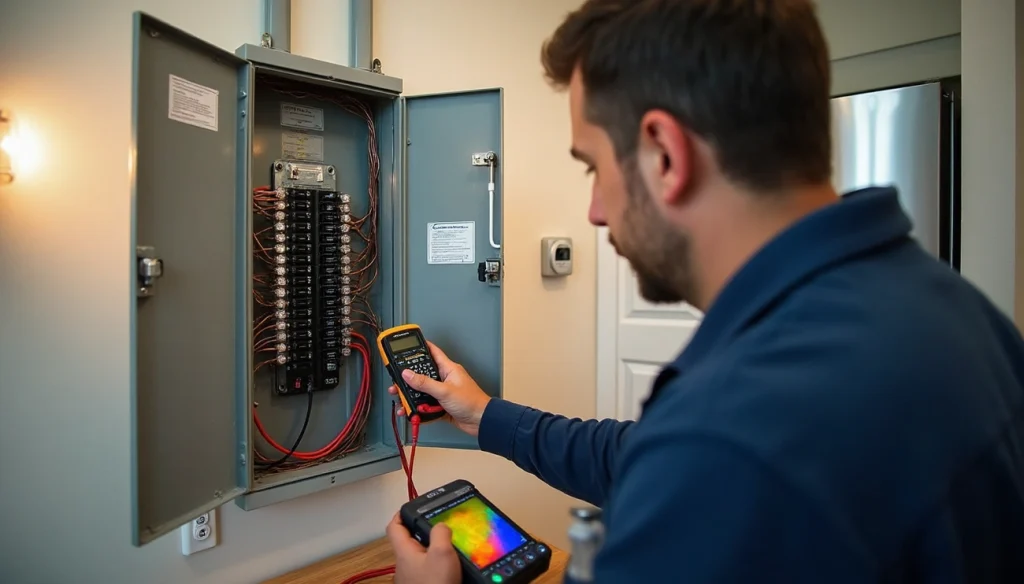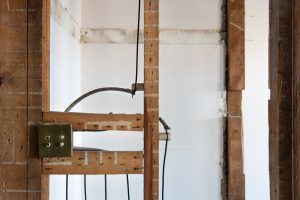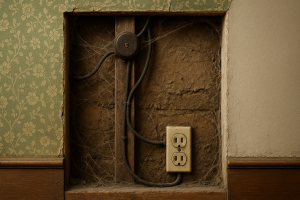Your home remodel needs proper electrical load calculations, since modern homes use up to 14 times more electricity than homes from the last century. Residential electrical panels have evolved dramatically. The 1960s panels averaged only 60 amps, but today’s panels deliver 150 to 400 amps to meet our growing power needs. Most homeowners skip this crucial planning step during renovations.
The meaning of electrical circuit load directly impacts your home’s safety. Your electrical system’s overload guides to overheating that can trigger fires or destroy expensive appliances. On top of that, it voids insurance claims if accidents happen because you didn’t follow electrical codes with proper house electrical load calculations. You need to master electrical load calculations not just to optimize power usage—but to protect your investment and keep your family safe. Correct electrical panel load calculations help you spot overloaded circuits, stop potential fires, and lower your monthly electric bills.
Why Remodels Increase Electrical Load Demand
Home remodeling projects often push electrical systems beyond their limits. Your existing system might not handle the power needs that come with modernizing your living space. Safety and functionality depend on how well you understand these changes in electrical load.
Smart appliances and EV chargers in modern homes
Today’s homes pack sophisticated technology that needs much more power. Research shows modern homes use up to 14 times more electricity than those built in the last century. Smart technology is the main reason behind this big jump in power usage.
Smart appliances need constant power to run their microprocessors, sensors, and network connections. While each smart device might save energy on its own, together they create a hefty electrical load. Many smart devices keep drawing power in standby mode just to stay connected to the network.
EV charging stations are another big power user in modern homes. A home Level 2 EV charger adds about 7,200 watts (7.2 kilowatts) or 30 amps to your home’s electrical load. This extra load can be risky if your electrical panel is already close to its limit.
Increased square footage and lighting requirements
Houses built after 1990 are 27% bigger than older ones. A home’s size relates directly to its power needs. Bigger homes need:
- Bigger lighting systems
- More outlets and circuits
- Extra refrigerators and appliances
Modern homes also have higher ceilings. Only 17% of 1970s homes had ceilings over eight feet, but 52% of homes built in the 2000s do. Higher ceilings mean you need stronger lights and more energy to heat and cool the space.
Central air conditioning shows up in 85% of newer homes built in the last 20 years. This has doubled the electricity used for cooling. Of all cooled space in U.S. homes – 139.8 billion square feet – over 40% comes from homes built in just the last two decades.
New HVAC systems and continuous load appliances
HVAC systems use the most electricity in homes – about 50% of total energy usage. Adding or upgrading HVAC during a remodel means you’ll need more electrical capacity.
The difference between continuous and non-continuous loads matters when calculating electrical needs. Continuous loads come from appliances that run non-stop, like refrigerators or water heaters. Electrical codes say circuits for these devices must be 25% bigger than their rated capacity.
Today’s homeowners often add several always-on appliances during remodels:
- Tankless or traditional water heaters
- High-efficiency refrigerators that need their own circuits
- Smart home hubs and security systems
HVAC experts look at your room count, sizes, and property type to figure out proper heating and cooling needs. Your HVAC system needs its own breaker to avoid breakdowns and system failures.
Older homes usually have outdated wiring that can’t handle modern power needs. Modern appliances like high-efficiency washers, dryers, and refrigerators often need their own circuits and more power.
What Is a Load in an Electrical Circuit?
Understanding electrical loads is vital for any homeowner planning a remodel. Essentially, an electrical load refers to any component of a circuit that consumes power and turns electrical energy into other forms like light, heat, or motion. Every appliance in your home represents an electrical load that affects your overall system performance.
Continuous vs non-continuous loads
Electrical loads fall into two basic categories based on how they operate. Continuous loads are devices that run for long periods. Electrical codes say a load is continuous when it runs for at least three hours. Common examples include refrigerators, air conditioners, electric furnaces, and water heaters – appliances that stay powered almost constantly.
Non-continuous loads are devices that cycle on and off periodically. These include televisions, gaming consoles, electric stoves, and window fans. The difference between these load types matters because electrical codes require circuits supporting continuous loads to be sized at 125% of their rated capacity. This safety margin helps prevent overheating in wires and connections that must handle current flow for extended periods.
Examples of high-load appliances
Some appliances just need more power than others. These high-load devices need special attention during electrical load calculations:
- Heating systems: Account for 31.3% of a typical home’s total energy consumption
- Water heaters: Consume approximately 13.6% of household energy
- Cooling appliances: Require 10.7% of total home energy
- Refrigerators: Use about 4% of residential power
- Clothes dryers: Consume 3.2% of home energy
These power-hungry appliances often need dedicated circuits to work safely. Ovens, HVAC systems, and washing machines should have their own electrical pathways to prevent overloading your panel.
Effect of simultaneous appliance usage
Your circuits face a bigger load when multiple appliances run at once. Running a 1,000-watt dishwasher, a 500-watt refrigerator, and a 600-watt computer creates a 2,100-watt load. This total effect matters a lot when calculating your home’s electrical requirements.
A simple formula helps you check if you’re approaching unsafe limits: Total wattage ÷ voltage = amperage. A standard 120-volt circuit with a 15-amp breaker should not exceed 1,800 watts (experts suggest staying under 1,500 watts for safety). Going over these limits can cause overheating and might damage appliances or create fire hazards.
High-wattage appliances like air conditioners, electric heaters, and computers should run on separate circuits. Warning signs like flickering lights show up when your system doesn’t deal very well with power demands.
Your system needs to handle your home’s growing demands safely without risking dangerous overloads or expensive equipment damage. Think about both individual power requirements and how new appliances will work with your existing electrical setup before adding them during a remodel.
How to Do Electrical Load Calculations Safely
Proper electrical load calculations are a vital step in any remodeling project. Incorrect calculations might create dangerous electrical hazards. Accurate assessments help your home’s electrical system operate safely and efficiently.
Using Amps = Watts / Volts
The relationship between three simple units forms the foundation of electrical load calculations: watts (power), volts (electrical pressure), and amps (current flow). The basic formula that connects these units is:
Watts = Amps × Volts
You can rearrange this formula to find amps when you know watts and volts:
Amps = Watts ÷ Volts
This formula helps determine if a circuit can handle an appliance’s electrical requirements. To name just one example, see a 1,500-watt hairdryer plugged into a standard 120-volt bathroom circuit – it draws 12.5 amps (1,500 ÷ 120 = 12.5). A typical 15-amp circuit maxes out at 1,800 watts (15 × 120), so this hairdryer comes close to the circuit’s capacity.
Calculating total wattage from appliances
Your home’s total electrical load starts with identifying each appliance’s wattage. Here are three quickest ways to get this information:
- Check the appliance nameplate – Most appliances show wattage information on their bottom, back, or nameplate.
- Multiply amps by volts – If you only see amperage listed, multiply it by the operating voltage (usually 120V for small appliances or 240V for larger ones).
- Use an electricity usage monitor – This device gives exact power consumption readings between an appliance and outlet.
Add together individual appliance wattage ratings after gathering them. Pay special attention to appliances on dedicated circuits like refrigerators, dishwashers, microwaves, and HVAC systems.
Applying 125% rule for continuous loads
Electrical codes have special rules for continuous loads—devices running for three hours or more continuously. Safety regulations require circuits supporting continuous loads to be sized at 125% of their rated capacity. The formula works like this:
Continuous Load Circuit Capacity = Continuous Load × 1.25
The 125% rule creates a safety buffer against overheating in wires and connections during extended use. Your electrical panel must be rated for at least 100 amps if your continuous loads total 80 amps (80 × 1.25 = 100).
Branch circuits supporting continuous loads use this calculation:
Branch Circuit Size = (Noncontinuous Load) + (1.25 × Continuous Load)
Using an electrical load calculations worksheet
A detailed and code-compliant calculation starts with an electrical load calculations worksheet. These worksheets follow Article 220 of the National Electrical Code and have:
- General lighting and power calculations (typically 3 volt-amperes per square foot)
- Kitchen small appliance circuits (minimum two at 1,500 volt-amperes each)
- Laundry circuit (1,500 volt-amperes)
- Major appliance nameplate ratings
- HVAC system requirements
The worksheet determines if your existing panel supports new loads or requires an upgrade. Safety regulations require an upgrade when the calculated load exceeds 80% of the panel’s capacity.
Local building departments provide standardized worksheets that follow the “Optional Feeder and Service Load Calculations” method from NEC Section 220.82. These worksheets apply the first 10,000 volt-amperes at 100% and the remaining load at 40%, giving a realistic picture of your home’s electrical demands.
Accurate calculations ensure your remodeling project has proper electrical capacity. This prevents dangerous overloads while making room for modern appliances and technologies.
Hidden Risks of Skipping Load Calculations
Skipping electrical load calculations during your remodel can hide serious dangers in your home. A simple shortcut today might get pricey or create life-threatening situations down the road.
Overloaded circuits and fire hazards
Overloaded electrical circuits stand out as one of the biggest causes of house fires. The National Fire Protection Association reports 47,700 home fires happen each year in the U.S. due to electrical failures or malfunctions. These fires lead to 418 deaths, 1,570 injuries, and $1.40 billion in property damage. The greatest risk comes from excessive current that makes wires overheat. This melts insulation and can create sparks that set nearby flammable materials on fire.
Flickering lights and voltage drops
Your electrical system sends warning signs through flickering or dimming lights. These visual signals show voltage changes because circuits run close to their maximum capacity. Your system doesn’t deal very well with power distribution when lights dim as large appliances turn on. These symptoms can show up anywhere in your house, not just one area, which points to systemic electrical problems.
Tripped breakers and panel overheating
Circuit breakers that trip often show your electrical panel works to stop dangerous overloads. In spite of that, resetting tripped breakers without fixing the mechanisms puts your home at risk. A hot electrical panel suggests power flow management problems. Watch out for breaker panels you can’t touch, buzzing noises, and burning smells. High temperatures that last too long can burn internal parts, which makes the panel unsafe.
Insurance and code compliance issues
Insurance companies look closely at electrical systems to evaluate risk. Outdated or non-compliant electrical panels raise the chances of fires and system failures by a lot, making them major liabilities. Many insurers won’t cover homes with old electrical systems. They might also reject claims if electrical fires happen because of non-compliant installations. DIY electrical work or unlicensed renovations make things worse by creating hidden dangers that look fine on the surface. The law says all new electrical systems must follow code guidelines—breaking these rules can bring big fines, project delays, and legal issues.
Electrical load calculations protect your home and family. They’re not just technical work to be done.
When to Upgrade Your Electrical Panel During a Remodel
A home remodel project needs careful planning about electrical panel upgrades. Your existing panel might not meet your home’s power needs anymore. Load calculations will tell you if it’s time for an upgrade.
Signs your panel is undersized
Your electrical panel needs an upgrade if you notice these warning signs:
- Your circuit breakers trip often when you run multiple appliances
- The lights flicker or dim as appliances turn on
- The panel feels warm or makes strange buzzing noises
- Your panel is more than 25 years old
- You can’t add any more circuit breakers
- You see scorch marks or smell burning
Homes built before 1980 likely have outdated panels that can’t handle today’s electrical needs. These older homes usually came with 60-amp to 150-amp service. Modern homes need 150-amp, 200-amp, or even 400-amp service.
Electrical panel load calculation for 100A vs 200A
Smaller homes under 3,000 square feet might do fine with a 100-amp panel if they don’t have central air conditioning or electric heat. A 200-amp panel becomes necessary for homes with central air conditioning.
You can get the full picture by adding up the amperages of all individual breakers. The total might be more than twice the panel’s rated capacity. A 100-amp service panel could have circuit breakers that add up to more than 200 amps. This is normal, but you need to manage your power usage carefully.
Adding 240V circuits for HVAC or EV chargers
Double-pole circuit breakers control 240-volt circuits needed for major appliances like electric ranges, water heaters, clothes dryers, furnaces, and air conditioners. You’ll need a panel upgrade if you plan to add:
- Electric vehicle (Level 2) chargers that use 30-50 amps
- Electric furnaces that need 60-80 amps
- Central air conditioning systems that draw 20-50 amps
Your remodeling project gives you the perfect chance to upgrade your panel along with other electrical changes. Panel upgrades cost between $1,500-$3,000. The price might go up if you need service upgrades.
Conclusion
Safeguarding Your Home Through Proper Electrical Planning
Electrical load calculations are the unsung heroes of successful home remodels. This piece shows why these calculations matter substantially for both safety and functionality. Today’s homes just need up to 14 times more electricity than century-old houses. Proper electrical planning isn’t optional – it’s essential.
Your family’s safety is at risk when you skip load calculations. Hidden dangers often surface when disaster strikes. Overloaded circuits can cause fires. Flickering lights point to voltage problems. Constantly tripping breakers signal serious electrical issues. On top of that, insurance companies might reject claims for electrical fires from non-compliant installations.
The formula “Amps = Watts ÷ Volts” serves as your first defense line for calculating electrical requirements. Note that you must apply the critical 125% rule for continuous loads to keep your system’s safety margins adequate. This helps you figure out if your existing panel can handle new loads or if it just needs an upgrade.
Your electrical system doesn’t deal very well with demand when breakers trip often, lights flicker, and panels feel warm. New additions like EV chargers, smart appliances, and modern HVAC systems usually mean upgrading from old 100-amp service to 200-amp or higher capacity.
A remodel gives you the perfect chance to assess and upgrade electrical systems. Panel upgrades cost between $1,500-$3,000. This investment looks small compared to what you could lose from electrical fires or system failures. Load calculations protect your property investment and your family’s safety.
The esthetic parts of your remodel matter, but electrical planning deserves equal focus. A well-calculated electrical system keeps your renovated home safe and efficient for decades.





